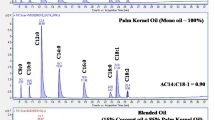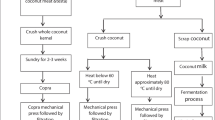Abstract
Economically motivated adulteration of expensive coconut oil with low cost oil, like palm kernel oil and palmolein is difficult to detect and quantify by available methods primarily due to their overlapping physicochemical properties with coconut oil. In the present work, a HPLC method has been developed to detect and quantify the degree of adulteration of coconut oil with palmolein and palm kernel oil based on triglyceride structure. The normalized area percentage of trilaurin (C36) among the three major TAG molecular species dilaurin-monocaprin/myristin-caprylin-laurin (C34), trilaurin (C36) and dilaurin-monomyristin (C38) of coconut oil was chosen as detection index for quantifying degree of adulteration of coconut oil with palm kernel oil, while the area ratio of dipalmitoyl-monoolein: trilaurin was chosen as detection index for quantifying adulteration of coconut oil with palmolein. The RP-HPLC based method developed in the present work is effective with a 2–4% minimum detection limit of adulterant oils and 78–98% detection accuracy depending on the degree of adulteration and types of oil.

Similar content being viewed by others
Abbreviations
- TAG:
-
Triacylglycerol
- LaLaLa:
-
Trilaurin
- CCC:
-
Tricaprin
- CyCyCy:
-
Tricaprylin
- MMM:
-
Trimyristin
- PPP:
-
Tripalmitin
- LaMLa:
-
Dilaurin-monomyristin
- LaCLa:
-
Dilaurin-monocaprin
- MCyLa:
-
Myristin-caprylin-laurin
- POP:
-
Dipalmitin-monoolein
- POO:
-
Diolein-monopalmitin
- ECN:
-
Equivalent carbon number
- CNO:
-
Coconut oil
- VCNO:
-
Virgin coconut oil
- PKL:
-
Palm kernel oil
- PML:
-
Palmolein
- FAME:
-
Fatty acid methyl esters
- CRM:
-
Certified reference material
References
AOAC (2000) Official methods of analysis of AOAC International, 17th edn. AOAC international, Gaithersburg, MD
AOCS (1989) Test for the presence of palmolein in other oil. Official Method of AOCS Ce 6–25
AOCS (2017) Tocopherols and tocotrienols in vegetable oils and fats. Official method of AOCS Ce 8–89
Azadmard-Damirchi S, Torbati M (2015) Adulterations in some edible oils and fats and their detection methods. J Food Qual Hazard Contr 2:38–44
Bartlet JC (1957) Identification of edible oils and the detection of oil adulteration by differential infra-red spectroscopy. Nature 180:1071–1072
Bosque-Sandra JM, Cuadros-Rodrigue L, Ruiz-Samblas C, Paulina de la Mata A (2012) Combining chromatography and chemometrics for the characterization and authentication of fats and oils from triacylglycerol composition data—A review. Anal ChimActa 724:1–11
Buchgraber M, Ulberth F, Emons H, Anklam E (2004) Triacylglycerol profiling by chromatographic techniques. Eur J Lipid SciTechnol 106:621–648
Catharino RR, Haddad R, Cabrini LG, Cunha IBS, Sawaya ACHF, Eberlin MN (2005) Characterization of vegetable oils by electrospray ionization mass spectrometry fingerprinting: classification, quality, adulteration, and aging. Anal Chem 77:7429–7433
EUR 22666N (2007) Detection and quantification of cocoa butter equivalent (CBE) in milk Chocolate
FAO (1997) Manuals of Food Quality Control (14/8) Test for the presence of cottonseed oil, Page 271
Goodacre R, Vaidyanathan S, Bianchib G, Kella DB (2002) Metabolic profiling using direct infusion electrospray ionisation mass spectrometry for the characterization of olive oils. Analyst 127:1457–1462
Green HS, Li X, De Pra M, Lovejoy K, Steiner F, Acworth IN, Wang SC (2020) A rapid method for the detection of extra virgin olive oil adulteration using UHPLC-CAD profiling of triacylglycerols and PCA. Food Control 107:106773
Herslof B, Podlaha O, Toregard B (1979) HPLC of triglycerides. J Am Oil Chemist’s Soc 56:864–866
ICMR (1990) Manual methods of analysis for adulterants and contaminates in foods: Test for presence of rice bran oil, Page 5
ISI (1984) Handbook of Food Analysis (Part XIII) Test for the presence of sesame oil, page 86
ISI (1984) Handbook of Food Analysis (Part XIII) Modified test for presence of Castor oil, page 91
ISI (1984) Handbook of Food Analysis (Part XIII) Test for the presence of mineral oil in edible oil, page 89
ISO 23275 (2006) Method for the Detection and Quantification of cocoa butter equivalent (CBE) in Dark Chocolate
Karthik D, Vijayarekha K, Manjula K (2012) Multivariate analysis for detecting adulteration in edible oil: a review. IEEE-IntConfAdvEngSciManag 31:272–277
Karthik D, Vijayarekha K, Manickkam V (2014) A simple method for detecting adulteration in sunflower oil using chemometry. Rasayan J Chem 7:99–103
Lee DS, Lee ES, Kim HJ, Kim SO, Kim K (2001) Reversed phase liquid chromatographic determination of triacylglycerol composition in sesame oils and the chemometric detection of adulteration. Anal ChimActa 429:321–330
Li Q, Chen J, Huyan Z, Kou Y, Xu L, Yu X, Gao J-M (2019) Application of fourier transform infrared spectroscopy for the quality and safety analysis of fats and oils: a review. Crit Rev Food SciNutr 59:3597–3611
Maggio RM, Cerretani L, Chivaro E, Kaufman T, Bendini A (2010) A novel chemometric strategy for the estimation of extra virgin olive oil adulteration with edible oils. Food Control 21:890–895
Manaf MA, Man YBC, Hamid NSA, Ismail A, Abidin SZ (2007) Analysis of adulteration of virgin coconut oil with palm kernel olein using Fourier transform infrared spectroscopy. J Food Lipid 14:111–121
Mansur AR, Jeong H-R, Lee BH, Koo M, Seo D-H, Hwang SH, Kim D-O, Nam TG (2018) Comparative evaluation of triacylglycerol, fatty acids, and volatile organic compounds as markers for authenticating sesame oil. Int J Food Prop 21:2509–2516
Moore JC, Spink J, Lipp M (2012) Development and application of a database of food ingredient fraud and economically motivated adulteration from 1980 to 2010. J Food Sci 77:R118-126
Neff WE, WmC B, List GR (2001) Triacylglycerol structure of food fats high in saturated acids by HPLC and mass spectrometry. J LiqChromatogrRelatTechnol 24:837–854
Pandurangan MK, Murugesan S, Shettu N, Gajivaradhan, (2017) Detection of adulteration of coconut oil using Fourier transform infrared spectroscopy and chemometrics. Int J Stat Appl Math 2:46–51
Park YW, Chang P-S, Lee J (2010) Application of triacylglycerol and fatty acid analyses to discriminate blended sesame oil with soybean oil. Food Chem 123:377–383
Park JR, Lee D-S (2003) Detection of adulteration in olive oils using triacylglycerol compositions by high temperature gas chromatography. Bull Korean ChemSoc 24:4527–4530
Pizzo JS, Galuch MB, Santos PDS, Santos OO, Visentainer L, Eberlin MN, Visentainer JV (2018) Assessment of adulteration of cosmetics based on vegetable oils by GC-FID and lipid profile using direct infusion electrospray ionization mass spectrometry (ESI-MS). J BrazChemSoc 29:2457–2465
Pizzo JS, Galuch MB, Santos PDS, Manin LP, Zappielo CD, Filho OJS, Santos OO, Visentainer JV (2019) Determination of coconut oil adulteration with soybean oil by direct infusion electrospray ionization mass spectrometry. J BrazChemSoc 30:1468–1474
Reena MB, Reddy SRY, Lokesh BR (2009) Changes in triacylglycerol molecular species and thermal properties of blended and interesterified mixtures of coconut oil or palmolein with rice bran oil or sesame oil. Eur J Lipid SciTechnol 111:346–357
Scott SM, James D, Ali Z, Ohare WT, Rowell FJ (2003) Total luminescence spectroscopy with pattern recognition for classification of edible oils. Analyst 128:966–973
Stolyhwo A, Colin H, Guiochon G (1985) Analysis of triglycerides in oils and fats by liquid chromatography with the laser light scattering detector. AnalytChem 57:1342–1354
Shahidi F (2005) Baileys industrial oil and fat product, vol 2. Willey, New York, pp 61–719
Vigli G, Philippidis A, Spyros A, Dais P (2003) Classification of edible oils by employing 31P and 1H NMR spectroscopy in combination with multivariate statistical analysis. A proposal for the detection of seed oil adulteration in virgin olive oils. J Agri Food Chem 51:5715–5722
Yang Y, Ferro MD, Cavaco I, Liang Y (2013) Detection and identification of extra virgin olive oil adulteration by GC-MS combined with chemometrics. J Agri Food Chem 61:3693–3702
Yang H, Irudayaraj J (2001) Comparison of near-infrared, fourier transform-infrared and fourier transform-raman methods for determining olive pomace oil adulteration in extra virgin olive oil. J Am Oil Chemist’s Soc 78:889–895
Zhang L, Li P, Sun X, Wang X, Xu B, Wang X, Ma F, Zhang Q, Ding X (2014) Classification and adulteration detection of vegetable oils based on fatty acid composition. J Agri Food Chem 62:8745–8751
Acknowledgements
The research work was carried out with the financial grant received from Food Safety and Standard Authority of India (FSSAI), Government of India (No. 75/R&D/Adulteration in Edible Oil/RARD/2016-FSSAI). We thank Director, CSIR-Indian Institute of Chemical Technology for the support (IICT/Pubs./2019/325).
Author information
Authors and Affiliations
Corresponding author
Ethics declarations
Conflict of interest
The Authors declare that they have no conflict of interest.
Additional information
Publisher's Note
Springer Nature remains neutral with regard to jurisdictional claims in published maps and institutional affiliations.
Rights and permissions
About this article
Cite this article
Komaram, A.C., Anjaneyulu, E., Goswami, K. et al. Detection and quantification of palmolein and palm kernel oil added as adulterant in coconut oil based on triacylglycerol profile. J Food Sci Technol 58, 4420–4428 (2021). https://doi.org/10.1007/s13197-020-04927-z
Revised:
Accepted:
Published:
Issue Date:
DOI: https://doi.org/10.1007/s13197-020-04927-z




